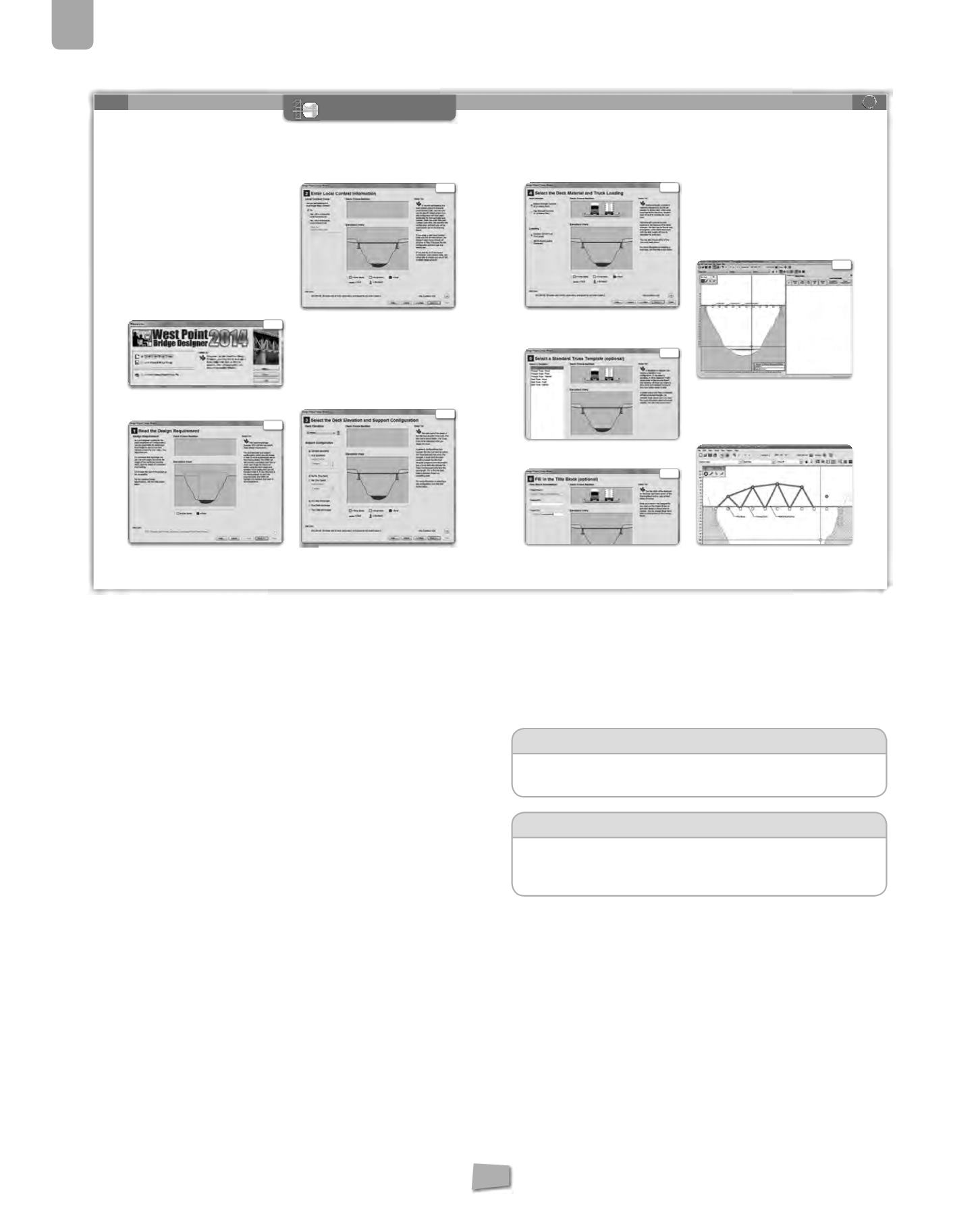
5
Structures
122
118
119
5. Structures
5
+
www
Working with a simulator lets you virtually test how
structures behave so that you can improve the design
before you build them. In this case, we are going to use
a simulator to test and improve the design of our bridge
before we build it.
It’sa freeonline simulator called
WPBD
(WestPointBridge
Designer). You can download it free from the webpage
.
The simulator lets you design a new bridge or adapt a
design and improve on it. In either case, the aim is to
make the best possible structure – a design that meets the
conditions at the lowest cost.
Let’s begin the simulation
❚
Phase 1: choose conditions and features
Screen 1.
We can choose to create a new design for our
bridge or to use a sample design. Let’s choose
Create a
New Bridge Design.
Screen 2.
Then describe the features of the land and the
bridge. Read and click on
Next.
Screen 3.
The simulator allows us to take part in a
competition. Choose
No
and continue.
Screen 4.
Now we can choose the height of the bridge
over the river. Remember that the higher our bridge is,
the longer the span will be, so our bridge will be more
expensive.
In the same way, with a higher deck your excavation costs
will be lower because you won’t have to dig or excavate
the sides where the bridge will rest.
In this case, our bridge will stand at 20 m, with flat beams
(Standard abutments),
without supports in the middle
(No
pier)
and no bracing
(No Cable Anchorage).
Screen 5.
Let’s choose the material for the deck of the
bridge and type of load. Choose the default settings.
Screen 6.
We can choose a truss design that we
know or invent our own
(none),
which will be more
interesting.
Screen 7.
Here we can give our project a name and
number if we want.
Screen 8.
The simulator explains the process that we
follow:
1.
Press
Finish
to go to the drawing screen.
2.
Draw the nodes or joints in the structure
(Tool/Joints).
3.
Draw the bars between the joints
(Tool/Members).
4.
Carry out a test to check if your design is stable and
resistant
(Test/Load test).
5.
Add or reinforce elements that failed in the test.
6.
Improve the resultby changing thepositionof thebars
to reduce costs.
❚
Phase 2
When you have pressed
Finish
1.
, you will see a screen
where you can draw the nodes (the joints between the
bars) and the bars that our bridge will have. With these,
we can make a first design
2.
and
3.
Screen 1
Screen 2
Screen 3
Screen 4
Screen5
Screen6
Screen 8
Screen7
Virtual testing of your design
STRUCTURE SIMULATOR
Virtual testing of your design
Students have the opportunity to test the design and check how
resistant it is, using a free online virtual simulator. The simulator is
West Point Bridge Designer, a programme that is free to download.
This programme offers two options. Students can create a new
bridge or work on pre-designed models. It is recommended that
students use the structure that they designed for the bridge.
This will give them an opportunity to correct any errors before
constructing the model.
At the end of the simulation, students will have achieved the best
possible structure in each case. The structure will not only meet
the necessary conditions but will be the most economical solution.
The simulation has eight steps or screens. In each one, the
student will need to choose certain options in order to complete
the design. However, the final screen is the most significant, as
it is where the design is drawn. As the structure is a bridge, the
student will need to take into account how the structure and each
of its elements will work when supporting a load.
The design then needs to be optimised in order to maintain
its resistance and other qualities, at the most economical cost.
Further guidance on this is provided.
It is possible to check the costs at any time, so that the student
knows whether the budget will increase or decrease according to
the choices they make.
Simulator:
WPBD
The simulator will enable students to determine the resistance of
any type of structure that they create.
Simulator:
BRIDGE CONTEST
Website in English with a free program or simulator that
allows students to experiment with different types of triangular
structures.


